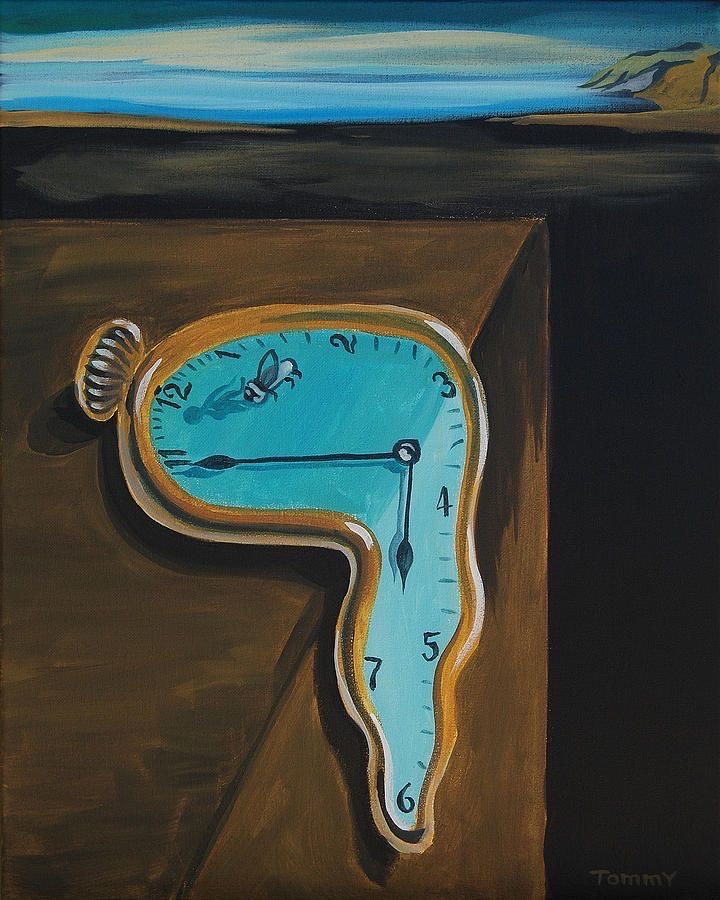The Elasticity of Time: Inside Dalí’s Dreamscape
Time is often imagined as rigid — a straight line moving forward, indifferent to our desires. Yet in Salvador Dalí’s world, time softens. It drips, folds, and stretches into a dream. Minutes and hours dissolve into something fluid, shaped not by clocks but by memory, emotion, and perception.
Dalí’s The Persistence of Memory (1931) remains the quintessential expression of this rebellion. Across a barren Catalonian landscape, soft clocks slump over tree branches and tabletops, their faces melting like wax. These clocks don’t measure; they surrender. They whisper that time is pliable, bending under the heat of consciousness.
Dalí later revealed that the inspiration came from a seemingly mundane observation — the sight of Camembert cheese melting in the sun. A simple wedge, softening under warmth, became a vision, a metaphor for time’s malleability. In his autobiography, he reflected on this “super-soft” nature of time — an idea born from taste and texture, transformed into philosophy. The melting watch became one of Dalí’s most enduring symbols, a reminder that time is subjective, molded by perception and memory.
While The Persistence of Memory captures the philosophical birth of the idea, Dalí’s Profile of Time sculpture brings its autobiographical depth into focus. The bronze, melted watch draped over a tree branch evokes his childhood memories, where vast, still landscapes left lasting impressions of suspended moments. In this work, Dalí blends the personal with the universal, crafting an emblem where memory, perception, and decay intertwine. Ultimately, Profile of Time challenges us to reconsider our understanding of time and memory, inviting us to explore their complexities through the eyes of one of the twentieth century’s most imaginative minds.
Dalí frequently employed hourglasses, ants, and barren landscapes to symbolize the relentless passage of time and its inevitable march toward decay. In The Disintegration of the Persistence of Memory (1954), painted decades after the original, the soft clocks shatter into floating blocks of matter. Against the backdrop of nuclear discoveries, Dalí reconceived time not only as soft but atomic — fragmenting into particles, unstable at its core. In these dreamlike landscapes, time becomes fluid, fractured, and endlessly refashioned.
Beyond clocks, Dalí explored the elasticity of time through myth and transformation. In The Metamorphosis of Narcissus (1937), the figure exists simultaneously as man, stone, and flower — collapsing before and after into a single suspended instant. In The Elephants(1948), colossal creatures with impossibly thin legs stride across endless plains, carrying obelisks that stretch proportion and duration. Across these works, time becomes a state of perception — a living, malleable experience rather than a rigid sequence.
Dalí believed that by transcending conventional perception, one could access truths hidden beneath ordinary reality. Through meticulous, Renaissance-like precision applied to the impossible, he invites the viewer to believe in paradox — to see logic within dreams and dreams within logic. His vision of time as elastic becomes a reflection of human experience: childhood summers that stretch endlessly, moments of joy that vanish in a heartbeat, grief that expands a single minute into eternity. Time, Dalí shows, is shaped by memory, emotion, and desire.
Dalí’s brilliance lies in fusing the personal and the universal, the real and the surreal — transforming time from a rigid measure into a boundless canvas of imagination.


